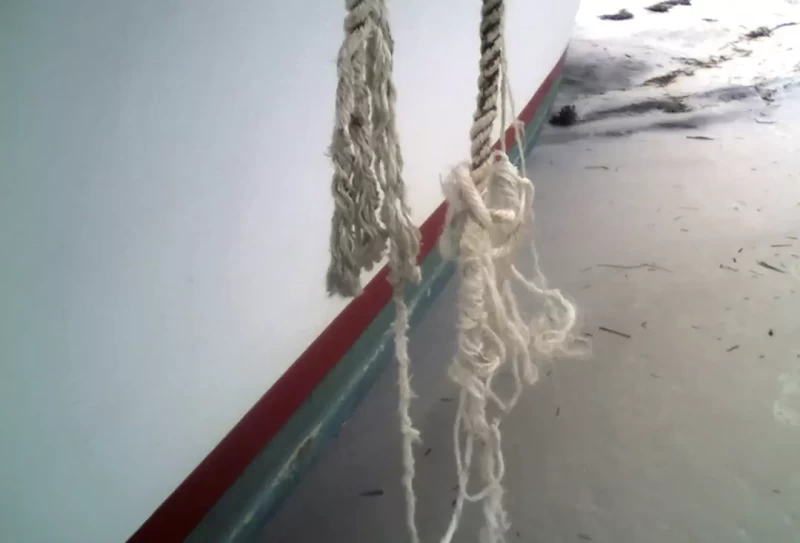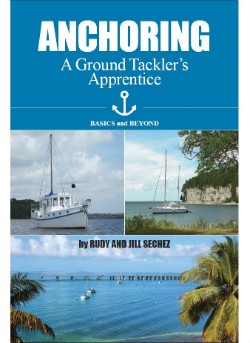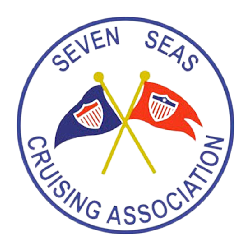In Ft. Lauderdale's Middle River, back when anchoring overnight was allowed, we pulled in and anchored. There was a sizeable ketch nearby which had several rodes off his bow laid out in a clock-like pattern, enabling him to swing in a limited space while in close quarters. We also noticed that his three rodes were twisted around one another suggesting that he'd been anchored here through many turns of the tide and wind.
Several days later we rowed over and offered to help this fella untwist his rodes, but his terse response was... "I've been here for a couple of months and my anchors are well dug in; I don't want to disturb them."
Within a week a squall hit and that boat was blown into an adjacent seawall. As his rodes were recovered we saw that two had long straggly ends, evidence that they had been chafing before they parted. The third also had an area of ragged fibers, but had yet to part; unfortunately, it was attached to an anchor that was woefully inadequate for the conditions, thus he dragged. Eventually, the boat was pulled back out and re-anchored.
This fella experienced the heartache of chafe, in this case the result of his rodes rubbing against each other, below the surface out of sight.

The problem of chafe can be compounded by the presence of several other issues. One is stretch, especially if repetitive or if the load exceeds ten percent of the rope's tensile strength. Stretch can cause the rope to chafe against whatever it lays against; it can even chafe fiber against fiber within the rope.
In addition, this rubbing creates heat and this heat can become severe enough to melt fibers. The presence of little hard nodules, either on the surface of or within the rope, indicates that the fibers had become hot enough to melt.
Another issue is when the rode is led over a bend that has a diameter less than three times the rope's diameter, which places the majority, if not all of the strain on the rope's outer fibers; the smaller the diameter of the bend, the greater this problem becomes.
Another is the fact that nylon rope loses approximately two percent of its strength per year, even if used and stowed properly; aged rope will also chafe easier than new rope. Therefore, older rope should be used cautiously and conservatively and only with loads below its published tensile strength.
Lastly, running a rope over an edge can accelerate chafe, not to mention the risk of the rope getting cut if the edge is sharp enough.
Below are several examples of anti-chafe techniques, each placed into an applicable category.
Reduce: This category includes keeping leads as fair as possible, making turns with large radii, and if the rope must touch anything, lubricating both the surface and the rope can help, even if it is just a slushing with water. Using large diameter rope provides much greater chafe resistance than smaller diameter rope. Running the rope through a block or over a roller is one of the best techniques for minimizing chafe.
Replace: This category would include using larger diameter line; another is to switch to a material that has better chafe resistance than does nylon, such as polyester, wire or chain... there is no harm in doing both.
Cover: This category would include techniques such as placing protective material, such as leather, polyester, fire hose or canvas, around the line at points of chafe. The more severe the conditions, the thicker the material should be, which can be attained by installing multiple layers which can be obtained by installing more than one layer.

Transfer: This category would include moving potential chafe to a less critical area; a good example is using a snubber when anchoring. With a rope rode, when slackened, the chafe will occur on the snubber, not the rode. Another idea is to periodically ease out the line, 'freshening the nip', so that any chafe is transferred to a new, undamaged section of the line.
These are not the only techniques for fighting against chafe; in addition to these few, there are many others anti-chafe techniques that can be employed; over forty are listed in the book, "ANCHORING-A Ground Tackler's Apprentice".

Find out more about veteran cruisers Rudy and Jill Sechez, Trawler Training and Anchoring Consultants, at their website: trawlertrainingabc.com. You can purchase their book, "ANCHORING−A Ground Tackler's Apprentice" through Waterway Guide Ship Store (waterwayguide.com).












